Bromeliads are a very diverse group of plants with thousands of individual species. The leaves and flowers of Bromeliads are sure to interest any gardener with their colourful combinations. These plants are Epiphytes in their native habitat, which means they grow in tree canopies and use the trees for support. Natural rainfall and leaf litter from above sustain the plant as it grows, and many different animals and insects rely on them for food and habitat. Small pools of water are retained in the cup of leaves at the centre and it is here that Frogs and insects live. Bromeliads make great houseplants and are also great for a protected , brightly lit spot out in the garden preferably out of the direct sunlight. Being native to Tropical regions of the World, they are happiest in temperate to warm climates. I took these photos of Bromeliads in Sydney.
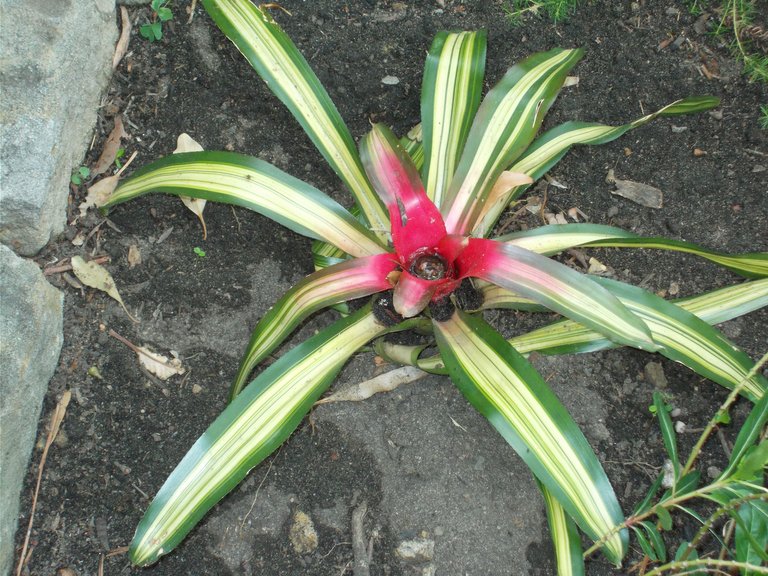
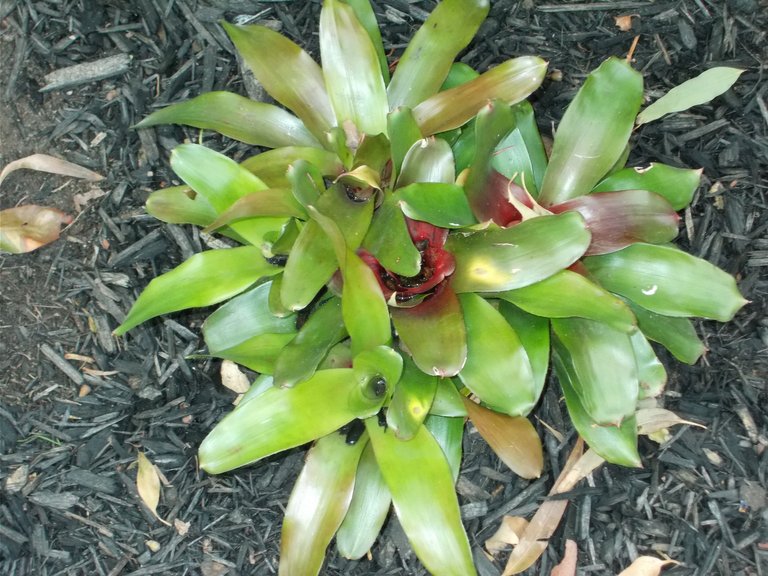
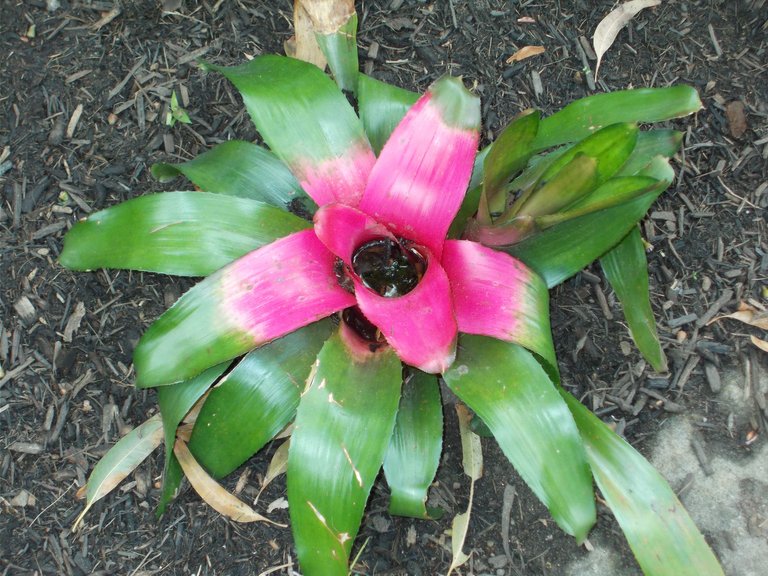
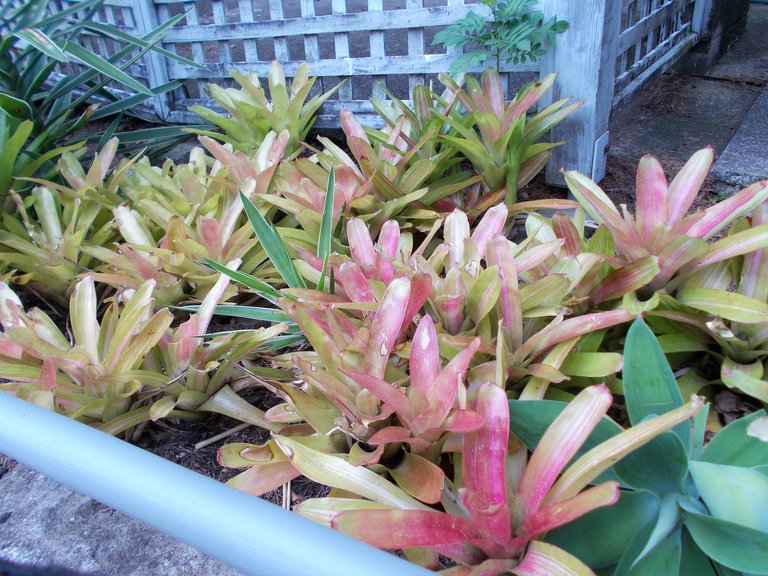
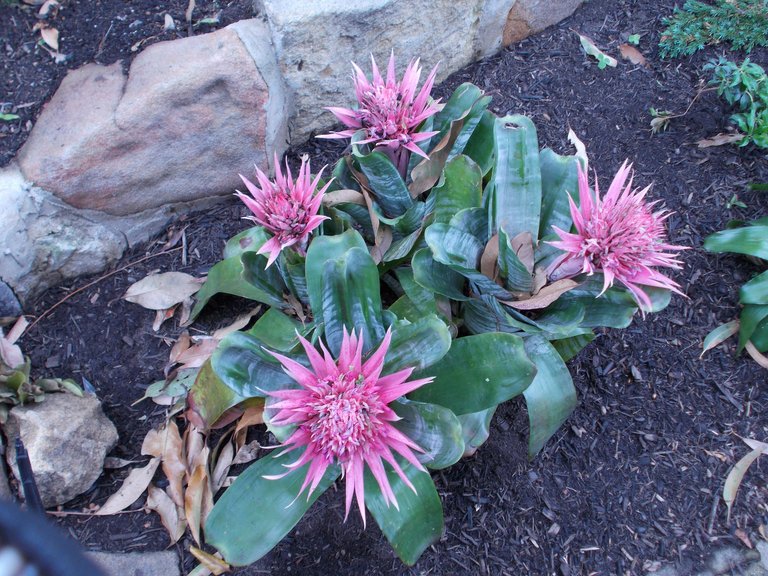
Bromeliads are members of a plant family known as Bromeliaceae with over 2700 described species in approximately 56 genera. The most well known bromeliad is the pineapple.
They are inexpensive, easy to grow, require very little care, and reward the grower with brilliant, long lasting blooms and ornamental foliage. They come in a wide range of sizes from tiny miniatures to giants. They can be grown indoors in cooler climates and can also be used outdoors in temperate areas.
Bromeliads can be grown in pots, in the garden, in greenhouses, on balconies, indoors or mounted on a tree or piece of wood. Many bromeliads don't need full sunlight and in fact, grow better in shady spots – that's why they're so successful under big trees.
Many hybrids are very colourful and easy to grow. They are epiphytic bromeliads, which have blue or white flowers, and various red spots and markings on the leaves.
The dramatic flowers of a bromeliad will last for at least six months. A plant's flowering season depends on the age of the plant and not the time of the year. The offspring created by a flowering bromeliad, will develop as the mother plant ages, and eventually take over.
Source
Great pics there, and you won the Silly Sausage Award for your comment. Well done !!
Thank you so much for generous support:)
Congratulations @anayakhan! Your info is really very informative.
Sir I am everyday your post resteemit and upvot done. I appreciate your blog.
There are more than 2,700 species of bromeliads. One of the most well-known bromeliads is the pineapple. Bromeliads typically have bright red, orange, purple, or blue flowers, and can grow in a number of different ways: they can be terrestrial, growing on the ground; saxicolous, growing on rocks; or epiphytic, growing on other plants and trees.
Epiphytic bromeliads have the ability to absorb nutrients and moisture from the atmosphere, so they are sometimes called "air plants." Hundreds of these plants can grow on branches of tropical trees, sometimes causing the branches to break under their weight.
Bromeliads are native to the Neotropics. One species now thrives in western Africa, and is thought to have been introduced accidentally. Many bromeliads have stiff, overlapping leaves which hold rainfall like buckets. Leaves and debris fall into these reservoirs and help algae and other single-celled organisms to grow, which in turn feed mosquitoes, insect larvae, and other organisms.
The bromeliad is like a small ecosystem in itself—animals such as tree frogs, snails, flatworms, tiny crabs, and salamanders might spend their entire lives inside them.
Source
Congrats, you will share the Fav.comment Award with one other. Your comment has great pics and info.
Thank you!
Bromeliads comprise an entire order of flowering plants called Bromeliales. The pineapple is the most familiar member of this tropical American group, which also includes some of the most interesting plants of the rainforest—the tank bromeliads.
Most bromeliads are epiphytes—that is, plants that live attached to other vegetation. Many live high above the forest floor, deriving energy from photosynthesis, water from rain, and nutrients mainly from falling debris and windblown dust.
The tank bromeliads have relationships with a wide variety of other organisms. The water held in the leaf rosette of a tank bromeliad forms a virtual aquarium, which may contain up to 20 litres (5 gallons) of water. Several hundred species of aquatic organisms can be found in these habitats, and some are found nowhere else except in bromeliad pools.
Among the creatures found here are fungi, algae, protozoa, and small invertebrates such as insects, spiders, scorpions, mites, worms, and even crabs. Vertebrate inhabitants of bromeliad tanks include frogs, salamanders, and snakes. Animal life, however, is dominated by insects, especially dipterans (two-winged flies) such as nonbiting midges and mosquitoes. On occasion, an aquatic species of bladderwort can be found floating in bromeliad tanks.
source: here
Like orchids, bromeliads are epiphytic, which means they grow on trees, rocks or other plants, and they get their water and nutrients from the air and rainwater. In many ways, caring for bromeliads is similar to orchids, so if you already have orchids, bromeliad plant care will be a snap!
Unlike most plants, they don’t get their nutrients from their roots, their roots are what they use to attach themselves to the growing support. Some types of bromeliad types can be difficult to grow as houseplants, because they like humidity and can dry out too quickly in the average home (especially during the dry winter months). But for the most part, bromeliads make great, easy-care houseplants.
Bromeliads are slow growing plants, and most of them will only bloom once in their lives. They are also short lived plants, and most bromeliad varieties will die after flowering.
Many people think that the large colorful growth that makes bromeliads so popular is the flower, which is a common misconception. But that is the flower bract, and not the actual flower. Bromeliad flowers grow out of the floral bracts.
Some bromeliad flowers are large beautiful spikes, and others are tiny and insignificant.
Source
My today’s visit to Longwood Gardens in Pennsylvania well known as one of the biggest botanical gardens in US, allowed me to share my own photographs of Bromeliads with short introduction of flower most gardeners love having in their own garden.
Cheerful, colourful, tropical and blessed with extraordinary appearances the Bromeliad has long been the most exotic beauty amongst houseplants. Commonly referred to as "air plants," bromeliads are native to the tropical Americas and are known for their signature arching, sword-like leaves that grow in a symmetrical rosette shape.
Pineapple and even Spanish moss are bromeliads, but some of the more common landscape varieties include the Aechmea and Neoregelia genera.The rosettes contain absorbent hairs and scales with which the plant absorbs water and nutrients. Bromeliads can be used for almost anything. You can strap them to trees or rocks, mount them on driftwood.
Bromeliads particularly need water in the rosette and sparingly on the soil. Watering once a week is sufficient. It’s also recommended to replace the water in the rosette regularly.
All photographs are taken by @rothberg with iPhone 6
Bromeliads are fascinating plants. They range from pineapples to spanish moss and come in a variety of shapes, sizes, colors and textures. Brazil is home to the most species of bromeliads. Most bromeliads only bloom once in their life.
Bromeliads don’t have one main flower. They actually produce an array of smaller flowers on spikes or inflorescences or in rosette shapes. Bromeliads with thin leaves like moisture, and those with thick leaves prefer dry conditions.
Pineapples are the only bromeliad fruits that are sold commercially throughout the world. Bromeliads can be found growing in three different ways. Terrestrial species grow with their roots in the ground (like most plants we are familiar with). Saxicolous species are found growing on rocks. Finally, Epiphytic species grow on other plants/hosts (usually trees), and get their nutrients from the air around them.
Tillandsia is the largest genus in the bromeliad family. Puya raimondii (see photo) is the largest species of bromeliad. The Puya raimondii may take 80 or more years to flower.
Source :http://www.bromeliads.info/bromeliad-facts/
Bromeliads plants and beautiful images. Totally stunning flowers there. You every time given beautiful gardening posts and best knowledge of your self. I add some details & beautiful pictures via web site.@ctrl-alst-nwo, That would be excellent review of
Bromeliad is the name for a family of plants that is incredibly diverse. There are 2,877 different species of bromeliads. And just about as many ways to care for them as there are different varieties. That being said there are a few things that will remain true for the majority of bromeliads and general principles of bromeliad care that will remain consistent. The following are tips for both indoor and outdoor bromeliad care and maintenance.
Almost all bromeliads are native to tropical climates. Their original habitat is humid and they grow on shady forest floors or attached to trees. This means bromeliads are adapted for warm, wet, shady climates. If you live in an area that will not freeze, you can safely plant your bromeliad outside. However, make sure you have a space that will not expose your bromeliad to large amounts of direct sunlight. A bromeliad can experience leaf burn if exposed to too much direct light. Different varieties have different tolerances for exposure to sun. Monitor your site to determine how much direct sun it receives and at what time of day and then purchase a bromeliad whose needs align with your site specifications. It is also important that your bromeliad remains mois
Thanks for given opportunity to share my comment.
Images found on google
contents source: http://www.bromeliads.info/general-indoor-outdoor-bromeliad-care/
That's because the most famous bromeliad is already in the production section of your local grocery store - Guzmania or Vriesea Other famous bromeliads? Pineapple or Spanish moss.And with over 2,700 known varieties of bromeliads, this plant family has tons of variet
![screen-shot-2018-03-20-at-3-28-15-pm.png]
Flower and beauty around spring time is created. Brightness is increasing.
magoo-2 found a series of multi accounts of a same owner is following your articles to cheat your generous rewards.
magoo-2 found these accounts are suspicious & can be multi accounts of a single owner. Conclusion is based on last 30 days transactions:
@farhad3322 @jack77
magoo-2
Check our latest multi comment spam update report
For a long time, bromeliads were considered advanced or expert houseplants, more fit for a greenhouse than a normal home, but bromeliads are finally beginning to attract the attention they deserve. The truth is, that bromeliads can be easily adapted to regular home conditions.
This is good news for the houseplant enthusiast because bromeliads are available in an astonishing array of colors and textures.
Even discounting their showy flower displays, bromeliads are beautiful foliage plants, with strappy leaves in red, green, purple, orange, yellow, banded, stripes, spots or other combinations.
There are actually several subfamilies of bromeliads. Pineapples and Spanish moss are both kinds of bromeliads. But the ones most often seen in cultivation are epiphytic plants that grow naturally in the tropical or subtropical regions of the Americas. As a general rule of thumb, bromeliads will thrive in the same conditions as epiphytic orchids. However, they are considerably more tolerant than orchids of fluctuations in temperature, drought, and careless feeding.
Source- https://www.thespruce.com/grow-bromeliads-indoors-1902667
beautiful piece of Bromeliads.😊
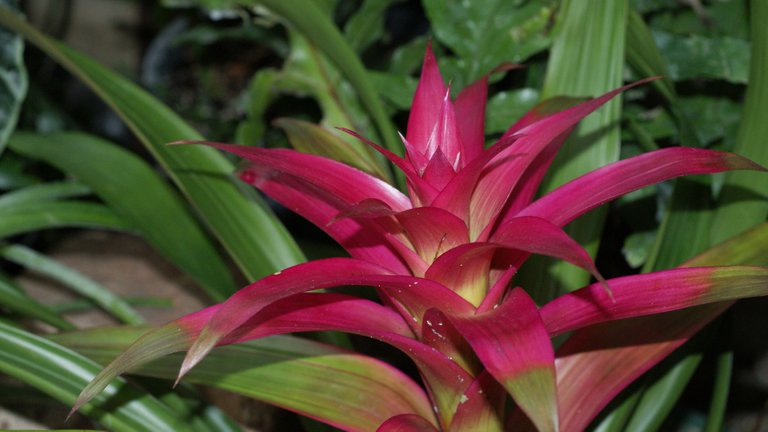
Bromeliads are members of a plant family known as Bromeliaceae with over 2700 described species in approximately 56 genera. The most well known bromeliad is the pineapple. The family contains a wide range of plants including some very un-pineapple like members such as Spanish Moss (which is neither Spanish nor a moss).
In general they are inexpensive, easy to grow, require very little care, and reward the grower with brilliant, long lasting blooms and ornamental foliage. They come in a wide range of sizes from tiny miniatures to giants. They can be grown indoors in cooler climates and can also be used outdoors in temperate areas. With few exceptions, the flower stalk is produced from the centre of the rosette. With rare exceptions, bromeliads only flower a single time.
Once the plant stops producing leaves and produces its flower, it will not start making leaves again. It will, however, vegetatively produce new plantlets called "offsets" or "pups". These plants will feed of the "mother" plant until they are large enough to set roots of their own and survive as a separate plant. The mother may sometimes survive a generation or two before finally dying off. Pups are usually produced near the base of the plant - inside the sheath of a leaf.
source of info
Bromeliad plants provide an exotic touch to the home and bring a sense of the tropics and sun-kissed climates. Growing a bromeliad as a houseplant is easy and brings interesting texture and color to the interior garden.
The plant is prized for its thick foliage that grows in a natural rosette. Near the end of its life, a bromeliad plant may produce an inflorescence or flower whose form and color vary widely among each variety. The wide leaves are sword shaped or scoop-like and grow around a central “cup.” This cup catches water in the plant’s habitat.
How to Grow Bromeliads :
These plants are widely available at nurseries and garden centers. The plants need medium to bright light as indoor specimens. New gardeners learning how to grow bromeliads will find that the plant doesn’t need deep pots or thick potting soils.
How to Care for a Bromeliad Plant:
Bromeliad plant care is easy and requires no special tools or fertilizers. Feed the plants with a half strength fertilizer every month in the growing season. Water needs are easily achieved by filling the cup at the base of the leaves. The water that collects in the pot should be emptied out weekly to remove debris and the dead insects the stagnant water tends to lure into the cup.
indetails
For a long time, bromeliads were considered advanced or expert houseplants, more fit for a greenhouse than a normal home, but bromeliads are finally beginning to attract the attention they deserve. The truth is, that bromeliads can be easily adapted to regular home conditions.
The most common bromeliads (such as the Aechmea, Neoregelia, and Guzmania genus) grow in rosettes of relatively large, strappy leaves around a central cup. These leaves are often relatively thick and may have backward facing spines that are capable of giving you a sharp jab.
The plants are highly adaptable, and for most people, it's actually better to grow them in a rich, fast-draining potting soil than it is to attempt to duplicate their native conditions.
Fortunately, bromeliads are beautiful foliage plants. No attempt is made to bloom them. In general, bromeliads need a fairly specific set of conditions to bloom—and these conditions vary from genus to genus. Their bloom cycle is affected by day length, temperature, humidity, water, and feeding.
Different genera of bromeliads are tolerant of different levels of light. Some can withstand full tropical sun, while others will quickly scorch. In general, however, the plants prefer well-lit, bright windowsills, but not direct sunlight.
source
Bromeliads are satisfying plants to grow at home partly because they're so easy to propagate. Over a few years, one bromeliad can turn into a whole garden of bromeliads. Most people get bromeliads as gift plants, when their colorful bracts are shooting up from the central plant cup. These bracts, which actually contain the bromeliads small flowers, last for a long time, sometimes months, before slowly fading and dying.
After the bract is dead, the "mother" plant will send out a series of offsets, or pups, from the base of the plant. They'll look like tiny versions of the mother plant emerging from between the mother plants bigger leaves. These pups can be used to propagate your bromeliad.
To take an offset, use a sharp shovel, long knife or saw. Cut the pup as far down as you can, even below the surface of the soil. Don't worry if the pup hasn't developed roots yet—bromeliads are epiphytes, which means their roots are only for holding and securing the plant.
They get their water and nutrition from their central cups. However, you want to get as much plant material as possible to help the young bromeliad stay firmly positioned in its new home.
magoo-2 found a series of multi accounts of a same owner is following your articles to cheat your generous rewards.
magoo-2 found these accounts are suspicious & can be multi accounts of a single owner. Conclusion is based on last 30 days transactions:
@readerhubs @imbooster
magoo-2
Check our latest multi comment spam update report
It doesn't belong to me! I don't remember what was the situation three months ago and I had to transfer to @imbooster! For your kind information the transfer contains a memo too. You never come to know about the purpose by just seeing the transfers! Keep your confusions with you and I don't care if you call me a duplicate as I don't have anything to do with that user.
scanbot - found a series of multi accounts of a same owner is following your articles to cheat your generous rewards.
scanbot- found these accounts are suspicious & can be multi accounts of a single owner. Conclusion is based on last 30 days transactions:
@readerhubs @imbooster
scanbot
Check our latest multi comment spam update report
Bromeliads are a family of plants (Bromeliaceae, the pineapple family) native to tropical North and South America. Europeans first found out about bromeliads on Columbus’ second trip to the New World in 1493, where the pineapple (Ananas sp.) was being cultivated by the Carib tribe in the West Indies. Source
Bromeliads flourish in tropical and subtropical climates, and are often used in these areas as bedding plants for outdoor ornamental plantings.
Bromeliads will survive for months or even years under less than ideal conditions. But in order to thrive you need to provide your plant with satisfactory light, temperature, humidity and keep them appropriately watered, fertilized and potted. Source
Bromeliads should receive 12 to 16 hours daily of relatively bright light. They can also be grown under fluorescent lights, with the lights hung about 8 inches above the tops of the plants.
Bromeliads prefer relative humidity of 50 to 75%, and need the higher levels as temperatures increase. But too high humidity seems to inhibit the formation of leaf scales, which may make some plants less attractive under these conditions. Source
Most species of bromeliads produce offsets after flowering, with the original plant slowly dying after blooming.
Pics source
Bromeliads
Botanical names: There are at least 50 genera in the bromeliad family, with at least 3,000 species and 6,000 cultivars. The most popular genera are listed here.
Common names: Bromeliad, vase plant, foolproof plant, queen's tears, air plant and more.
Mature size: Varies, depending on the cultivar. The "hanging mosses" of the South are actually clumps of tiny air plants, while the enormous Puya raimondii can reach over 30 feet tall.
Feeding: Feed bromeliads with a diluted orchid fertilizer or slow-release fertilizer. Highly colored and mottled specimens look best when fertilized sparingly.
Planting and designing with bromeliads couldn't be easier. Since most have limited root systems, they're relatively easy to dig up and relocate as needed, which is especially useful for growers who experience freezes in winter.
Everyone deserves to have at least one bromeliad on a windowsill or in a garden.
So beautiful garden, thanks for sharing
Resteem
Main varieties
Stephanie displayed guzmanias, neoregelias and some air plants including Spanish moss (Tillandsia usneoides). Many bromeliads are very colourful but this colour comes from floral leaves or bracts which hold the smaller, less obvious flowers. Many bromeliads colour more vibrantly when the plants are flowering. These are the main bromeliads sold in Australia today:
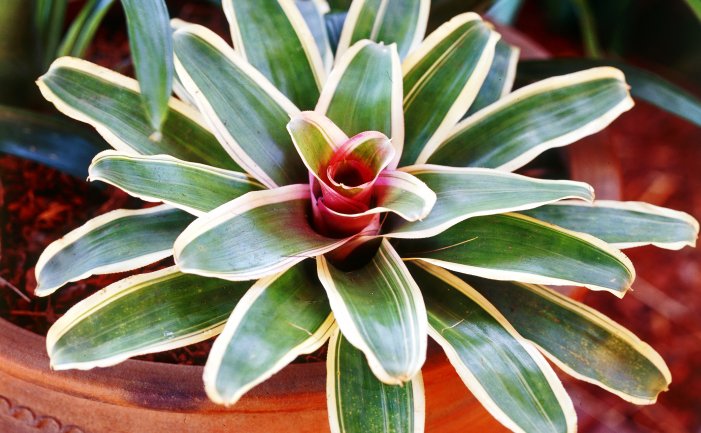
Aechmea: The plants in this genus are mostly epiphytic. One of the best known is Aechmea fasciata or ‘Silver King’, which has long lasting, pretty pink flowers and is often used as an indoor plant.
Ananas: The commercially grown pineapple, Ananas comosus is a member of this genus.
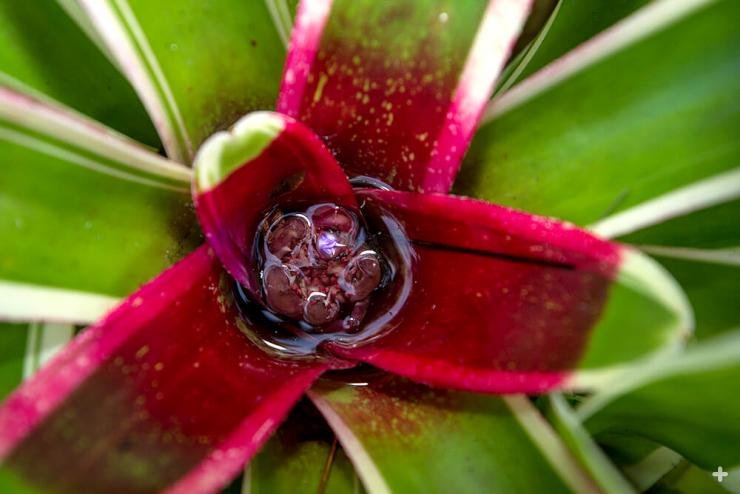
Billbergia: There are around 60 species of Billbergia, which are colourful and well suited to growing in the garden around the base of trees. They clump up quickly to form good flower displays, although the inflorescence (flower head) on some species is short lived.
Cryptanthus: This is a terrestrial group from Brazil, which needs plenty of room for root development. They are best suited to warm climates.
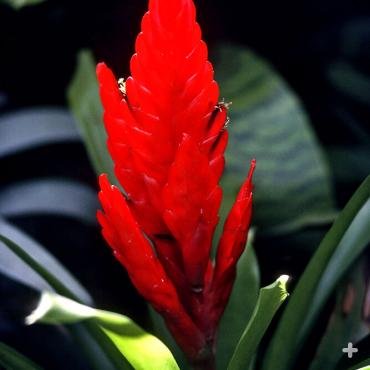
Vriesea: Plants in this genus have interesting and varied foliage, and sword like eye-catching flowers. They are easy to grow and are good bromeliads for beginners to try.
Tillandsia: True air plants, tillandsias range in size from the tiny T. bryoides (1cm or 0.4″) to the giant T. grandis which can grow up to 3 metres (9′) tall. Also in this group is T. usneoides, commonly known as old man’s whiskers or Spanish moss, which looks like spider webs hanging from the trees. Apart from its ornamental uses, this material can be used for padding in upholstery.

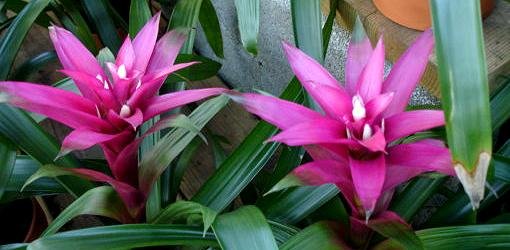
Guzmania: Members of this family have beautiful green foliage and colourful, big open flowers. The coloured flower spikes last many months.
Neoregelias and their many hybrids are very colourful and easy to grow. The inner leaves of many species turn a brilliant reddish colour just before flowering. The most commonly grown species is Neoregelia carolinae, also known as the ‘Blushing Bromeliad’.
Bromeliads are beautiful foliage plants, with strappy leaves in red, green, purple, orange, yellow, banded, stripes, spots or other combinations. There are actually several subfamilies of bromeliads. Pineapples and Spanish moss are both kinds of bromeliads. he leaves arise from the center cup, which is designed to hold water. In nature, bromeliads' roots are adapted to clinging onto trees. he plants are highly adaptable, and for most people, it's actually better to grow them in a rich, fast-draining potting soil than it is to attempt to duplicate their native conditions. After the flower dies, the plant begins to die also, and over the next few months, will decline. However, the mother plant will send out one or several smaller pups at the base of the plant. These pups can be carefully cut off with sterile snippers and potted up individually. Pups should only be potted up after they develop a few roots and begin to form the central cup characteristic to bromeliads.
Wow its an interesting and amazing gardening flower! Bromeliads have beautiful foliage, but they are often sought after for their inflorescence and the colorful leaves that accompany blooming. Unfortunately bromeliads, with the exception of a few genera, bloom only once. New plants will grow, but often they need some encouragement to produce a new flower.
These plants are widely available at nurseries and garden centers. The plants need medium to bright light as indoor specimens. New gardeners learning how to grow bromeliads will find that the plant doesn’t need deep pots or thick potting soils. They do even better in shallow pots and may grow in low soil mediums such as orchid mix, a blend of bark, sphagnum moss and other organic amendments.
Thanks to share this beautiful flower.
Magoo-2 found a series of multi accounts of a same owner is following your articles to cheat your generous rewards.
Magoo-2 found these accounts are suspicious & can be multi accounts of a single owner. Conclusion is based on last 30 days transactions:
@rupok @sarahmcdowell2 @razu788 @tangera
magoo-2
Check our latest multi comment spam update report
Look no further than the beautiful Bromeliad. This little beauty has many different flowers and makes the perfect accent to any space. This much-loved houseplant well-known for its interesting and long-lasting flowers (up to three months!) and variety of colours - orange, pink, red, purple and yellow. The wide fleshy leaves are often variegated.
USES:
Bromeliads are used as indoor and landscape plants. They are epiphytes and the many types have striking foliage colours and others are grown for their colourful and long lived flowers.
PLANT CARE:
Bromeliads tolerate a broad spectrum of light but are best kept away from full sun. They prefer warm temperatures but will tolerate temperatures down to 15 degrees celcius. As ephiphtyes they are relatively drought tolerant which has made them a popular landscape plant in arid climates. Water inside the rosette and feed monthly during the summer with a balanced liquid fertiliser into the rosette. Always ensure the rosette has water. Repot offsets in the spring.
Bromeliads:
Unlike seasonal plants, it’s always Bromeliad season. While they can be planted outdoors, they tend to do best when kept in consistent warm temperatures indoors. Though there are some exceptions, the majority of bromeliads bloom just once. But don’t worry: Your mother plant will produce new plantlets—also called “pups”—allowing your bromeliad to be constantly in bloom, even once the original plant is done flowering.
Most bromeliads are native to Brazil, so indoor plants do best when kept away from drafts and in temperatures above 55 degrees. Bromeliads use their roots for balance, not for transferring nutrients. Instead, the leaves take in all of the water and nutrients the plant needs. Some species of bromeliads even grow on rocks or trees.
These versatile and exotic plants can add significant intrigue and beauty to your home décor.
#https://www.justaddiceorchids.com/orchid-care-blog/8-interesting-facts-about-bromeliads
In the wild, most bromeliads grow on trees and some grow in the ground, on rocks and cliff walls. Some are epiphytes, getting their water and nutrients from the atmosphere, and some have “tanks” that collect water and fallen leaves. As these leaves and other organic material that collects in the tanks decompose, they provide the nutrients needed for the bromeliads to grow.
Bromeliads are low-maintenance plants that can be grown as houseplants, in containers and as landscape plants in this part of Florida. They are also a favorite in the Florida-friendly landscape because they need little, if any, supplemental water or fertilizers.
only have a few bromeliads on you property, there is little to worry about when it comes to the mosquitoes that transmit Zika. You want to remain vigilant, however, and be aware of other sources of potential mosquito breeding such as backyard tire swings, birdbaths and anything else that can hold standing water.
Source:-http://www.news-journalonline.com/article/LK/20160608/News/606119683/DN/
Such a beautiful plant, the bromeliad catches water in its funnel like leaf setup and often looks like pools of blood inside. The roots of the Bromeliad don't frame in the ground. Rather they develop on top of rocks (saxicolous) and trees (epiphytic) and are in this manner regularly called "air plants".
Whether they are big or small; grow in the ground, on rocks, or in trees; and live off nutrients from moisture in the air or water collected in their leaves, bromeliads come in a wide array of shapes, sizes, and colors, including plants from both deserts and rain forests. Bromeliads can be found throughout Central and South America and parts of North America, in many habitats and climates—ranging from sea level to mountainous elevations of up to 14,000 feet—with the largest number of species found in Brazil. Some bromeliads, notably Spanish moss, can be found as far north as Virginia in the US.
Bromeliads are plants that are adapted to various climates. Foliage takes different shapes, from needle-thin to broad and flat, symmetrical to irregular, spiky to soft. The foliage, which usually grows in a rosette, is widely patterned and colored. Leaf colors range from maroon, through shades of green, to gold. Varieties may have leaves with red, yellow, white and cream variations. Others may be spotted with purple, red, or cream, while others have different colors on the tops and botecies Tillandsia cyanea have a fragrance resembling that of clove spice.
Beautiful Pink with blue bubble tipped bromeliad with a honey bee spotted in Baguio, Philippines. Stout straight flower stems rise (30 to 45cm) from the centre of the plant above the foliage, carrying numerous individual flowers. Flowering stems are produced several times a year and last for many weeks.



The Bromeliad is a wonderful houseplant and especially kind to those who do not have green thumbs.
I feel a lot of nostalgia and many moments come to my mind, as the one expressed in this photo I do not remember well the date we took it I think it was in April or March of this year, but I think it is very beautiful because it identifies a mixture of elements natural with a beautiful pink harmonic color this plant is called Bromelia, it is a noble plant that with little real care, every garden decorating it with its different tonalities ..
gardening is also my hobby and i love garden flower plants too. I never see this kind of beautiful pink, The Bromeliad. Pics are really awesome.
Thanks for sharing
Interesting plants. That's what I learned about it. Bromelia - the plant is considered to be a species of Bromeliaceae, which includes up to 50 representatives. His name was received in honor of the Swedish healer XVI-XVII century Olaf Bromel. A plant that lives many seasons both on land and on trees, as an epiphyte. Homeland growing is considered the tropical areas of America. Bromelia has the appearance of a herbaceous plant, in extreme cases, it can be a shrub that consists of elastic, with sufficient stiffness of leaves, constituting a dense rosette. In natural nature, rainwater is filled into this outlet and various natural debris falls, which serves as a nutrient for the plant. Bromelia has a very small root system. The most famous of the representatives of bromeliads: pineapple, guzmania, striped ehmya, vriesia, thillandsia.
The video shows this plant very well.
https://tutknow.ru/garden_and_orchard/4492-bromeliya-8213-vyraschivanie-v-usloviyah-doma-ili-ofisa.html
Beautiful Bromelia
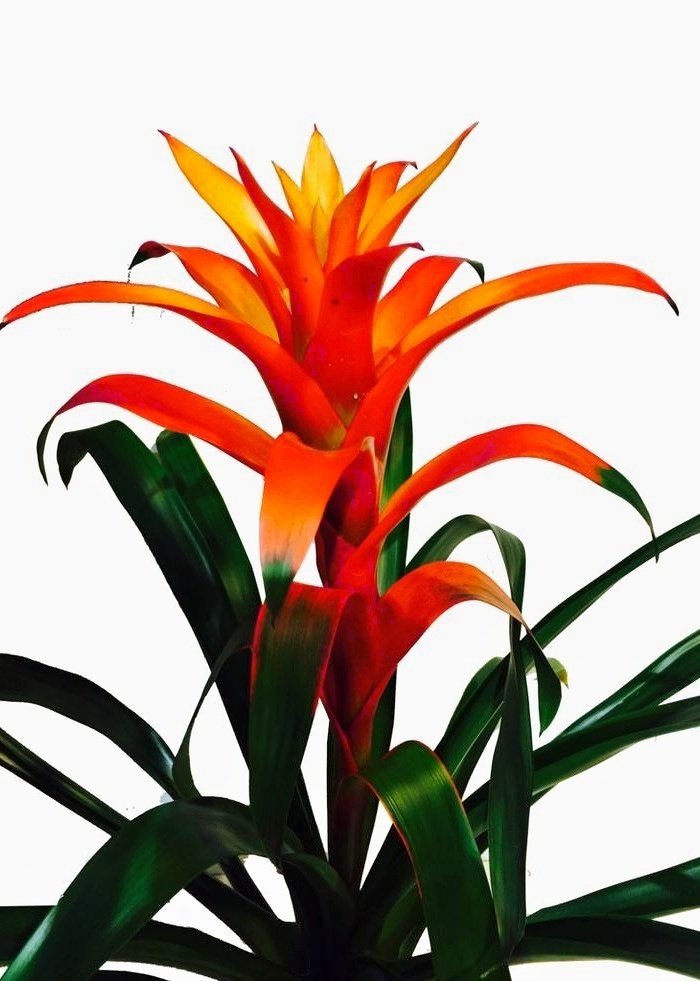
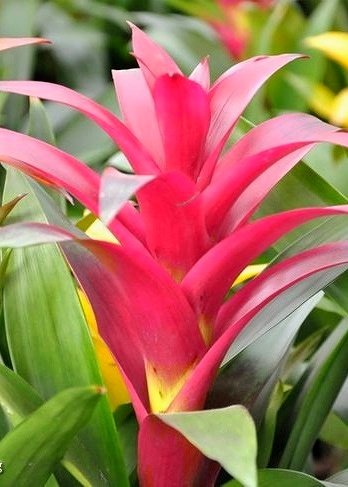
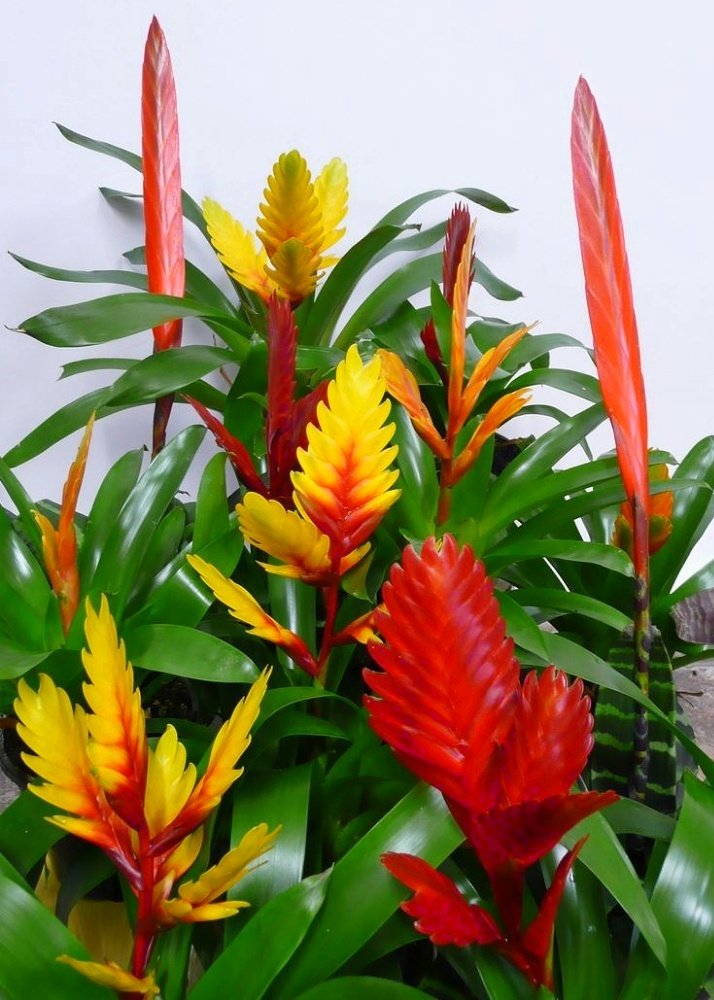
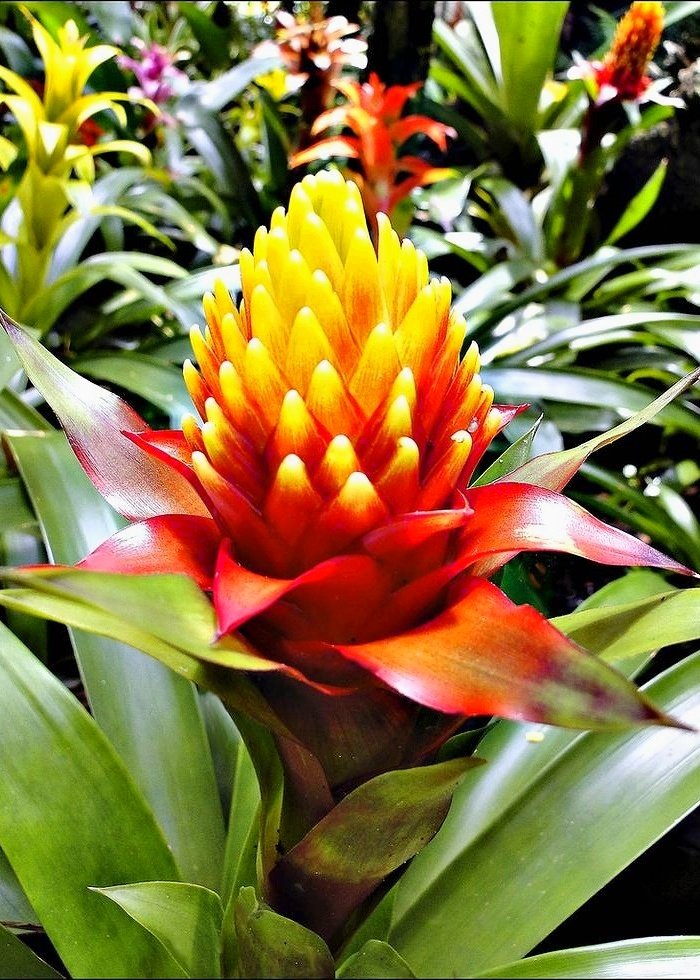

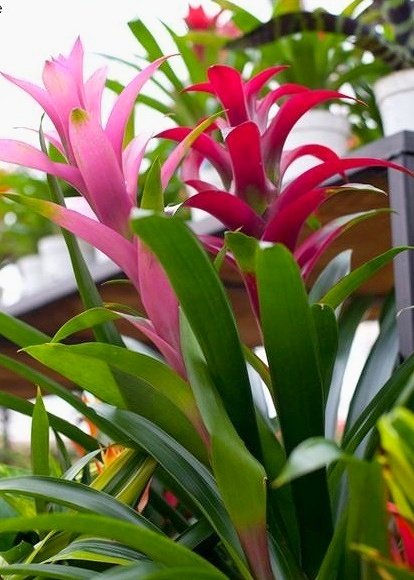
Bromelia is a plant belonging to the Bromeliaceae family.
Bromelia is the only plant that has an inferior septal and ovarian cubicle.
Bromelia leaf shape is different. There is a thin, flat, pointed, and soft shape.
Leaf color ranging from maroon, green, yellow, cream, purple, until there is a golden color.
Bromelia root has a complex root system for collecting water and nutrients.
Bromeliads can grow on rocks, soil, and dry areas exposed to direct sunlight.
Thereby! May be useful!
Magoo-2 found a series of multi accounts of a same owner is following your articles to cheat your generous rewards.
Magoo-2 found these accounts are suspicious & can be multi accounts of a single owner. Conclusion is based on last 30 days transactions:
@seha76 @faisalrizal2018 @roman-sabil
magoo-2
Check our latest multi comment spam update report
Bromeliads are unique plants that make gorgeous additions to any indoor plant collection. They are pretty easy to grow indoor plants, but caring for bromeliads is quite different than caring for your average houseplant. Don’t worry, bromeliad plant care isn’t difficult, it’s just… well, different.
Like orchids, bromeliads are epiphytic, which means they grow on trees, rocks or other plants, and they get their water and nutrients from the air and rainwater. In many ways, caring for bromeliads is similar to orchids, so if you already have orchids, bromeliad plant care will be a snap! Unlike most plants, they don’t get their nutrients from their roots, their roots are what they use to attach themselves to the growing support.
Bromeliads are slow growing plants, and most of them will only bloom once in their lives. They are also short lived plants, and most bromeliad varieties will die after flowering. Sad I know, but they usually have lots of babies before they die so you’ll get even more plants out of the deal (but more on that later).
https://getbusygardening.com/bromeliad-plant-care/
This species is one of the most diverse types of plants in the world @ctrl-alt-nwo
Watering Bromeliads: How To Water A Bromeliad Bromeliads By:
Heather Rhoades Image by kimubert When you have a bromeliad to care for, you might be wondering how to water a bromeliad. Watering bromeliads is no different than any other houseplant care; check your houseplants regularly for their soil being dry. Most plants need water when they are dry unless they are a picky plant, in which case, you should have some sort of direction as to how to handle the watering.
The Bromeliad Water Tank Bromeliads grow in a many different conditions.
When taking care of a bromeliad, water it well. The center of a bromeliad is called a tank or cup. This particular plant will hold water in its tank. Fill the tank in the center and don’t allow it to get empty. Don’t let the water sit for a long time or it will stagnate and possibly cause damage to the plant. Also, salt builds up so it’s best to flush it out. You will also need to change the water frequently, about once a week. Let the excess water drain in a drain pan or plate, and let the plant dry out before you decide to water it again. Best Water for Bromeliads If you can use it, rainwater is the best water for bromeliads because it is most natural. Distilled water also works well for watering bromeliads. Bromeliad water can also be tap water, but there may be a build up of salt and chemicals from tap water. Bromeliads are tough, carefree plants indoors. They provide color to a room and any problems you might encounter can be fixed pretty quick because the problems are usually caused by overwatering or failure to change the water. If your bromeliad is an outdoor plant, be sure to bring it in during freezing weather. If it freezes, there will be damage to the plant from the water in the tank.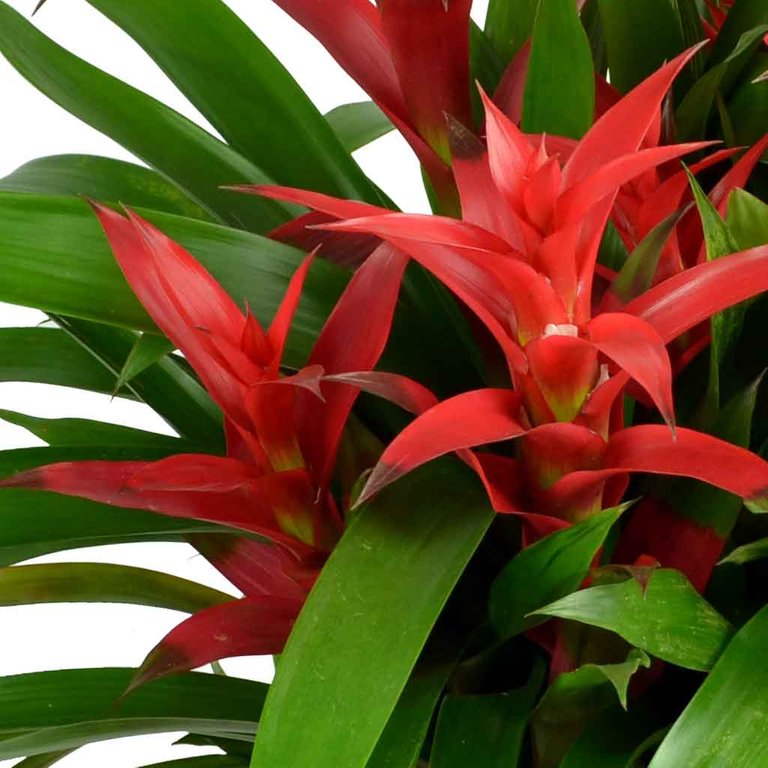
Rewards for Watering Bromeliads
Healthy bromeliads come from being taken care of well. If you want to enjoy your plant for months and months, you want to be sure to take care of it. Remember that the water can be rainwater, filtered water or tap water, that watering bromeliads should be done when the soil is dry; and that how to water a bromeliad is not much different than watering any other houseplant.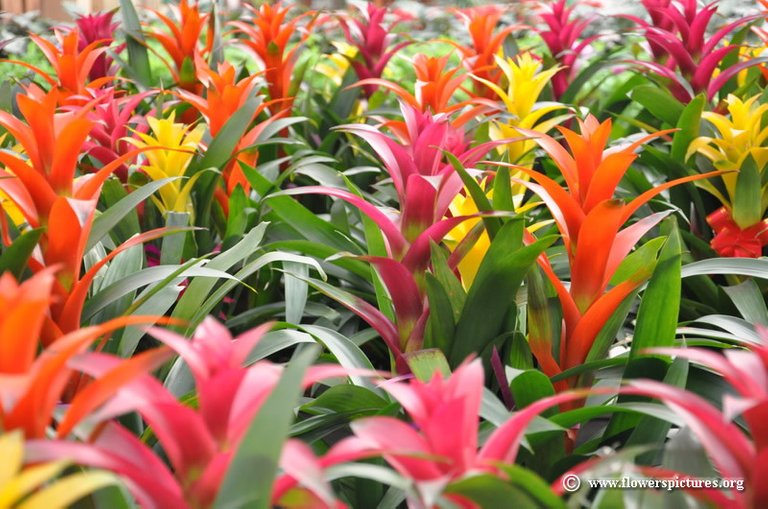
Source
Instructions to Grow Bromeliads
These plants are generally accessible at nurseries and garden focuses. The plants require medium to splendid light as indoor examples. New plant specialists figuring out how to develop bromeliads will find that the plant needn't bother with profound pots or thick gardening soils. They improve in shallow pots and may develop in low soil mediums, for example, orchid blend, a mix of bark, sphagnum greenery and other natural corrections.
The most effective method to Care for a Bromeliad Plant:
Bromeliad plant mind is simple and requires no unique devices or manures. Nourish the plants with a half quality compost each month in the developing season. Water needs are effectively accomplished by filling the container at the base of the takes off. The water that gathers in the pot ought to be purged out week by week to evacuate flotsam and jetsam and the dead creepy crawlies the dormant water tends to draw into the glass. Set the pot in a saucer of rock filled somewhat with water to build dampness and help give a clammy climate.
That’s amazing for flower that beautiful not being only flower, but also source of water and actualy home for some small frogs and insects.
Bromelaid is very beautiful**
Some detail about Bromelaid
Bromeliad plants provide an exotic touch to the home and bring a sense of the tropics and sun-kissed climates. Growing a bromeliad as a houseplant is easy and brings interesting texture and color to the interior garden. Learn how to care for a bromeliad plant and you will have a long lasting unique houseplant that is low maintenance.
source
I don,t know too much about this plant because it is very rare in in country but i have searched on internet and i get alot of information about this .
Source
Bromeliaceae :
A barbaric name that probably rings oddly in your ears! In fact, it is tropical plants some of which flourish in our homes like bilbergia, aechmea and tillandsia. The most popular is probably the aechmea: a strange plant, with large leaves very rigid silvery green, in the center of which opens a flower of an almost electric rose, punctuated with small purplish spots (the true flowers of this amazing inflorescence).
Watering:
For your plant to live well, there is something to know: it should not be watered by the foot, but pour the water in the center of the leaves (preferably use non-calcareous water not to leave ugly traces white). Let it evaporate and renew every month.
Flowering :
All bromeliads have in common to bloom only once on the same foot: it is useless to wait for your plant to bloom again. On the other hand. the rejections all around the mother-plant are quite capable of doing so. But sometimes, they take a long time to decide. To force them to bloom here are two things:
i love this flower
in my garden there have many of this flower of this
Flowering Bromeliads
Most bromeliads produce a flower stock (called bracts) from the center of the rosette, some are long and some are quite short with a single flower or many individual ones.
![1452645376796.jpeg]
Before a bromeliad flowers, it stops producing leaves. The one-time flowering stage might bloom for a long time, but the plant sadly dies one to two years after this stage. It does produce new plant-lets near its base called “offsets” or “pups.” Feeding off the mother plant, these little pups grow until they are large enough (around 5 months and 6″ tall) to set roots of their own to survive as a separate plant and can gently be cut-away from the mother. The pineapple’s pup sits atop the fruit and can be removed and planted to start a new plant.
Caring for a Bromeliad
It might seem that bromeliads need a lot of care. Actually they are fun, easy to care for and provide spectacular ornamental foliage with brilliant blooms. Everyone should have at least one in their home or office to allow the graceful aesthetics from these plants spread through the rooms. Bromeliads do best in shallow pots with low soil mediums that contain a blend of bark, sphagnum moss and other organic amendments. Orchid mix is one such soil mix you can use. (https://gateway.ipfs.io/ipfs/QmXPH3ZcauAKXi7A6PHJKwisRChZkShVus4dpPJXAq2Ri6)
To water, fill the cup formed at the base of the leaves with water. Remove the water that collects in the container once a week. Also, set the container in a saucer of gravel and fill it with water to provide a moist atmosphere for the plant. Do not let the roots sit in the water which could lead it to rot.
Magoo-2 found a series of multi accounts of a same owner is following your articles to cheat your generous rewards.
Magoo-2 found these accounts are suspicious & can be multi accounts of a single owner. Conclusion is based on last 30 days transactions:
@rahmanmdriad @mdriadrahman26 @masterlegend
magoo-2
Check our latest multi comment spam update report
scanbot found a series of multi accounts of a same owner is following your articles to cheat your generous rewards.
scanbot found these accounts are suspicious & can be multi accounts of a single owner. Conclusion is based on last 30 days transactions:
@rahmanmdriad @mdriadrahman26 @masterlegend
scanbot
Check our latest multi comment spam update report
I am here with somre information about bromeliads.
Bromeliads
Bromeliads are a family of tropical plants.They are nearly all from Latin America and the Caribbean islands, except for Spanish moss from the southern United States, and a single kind from Africa.
Different sorts of bromeliads
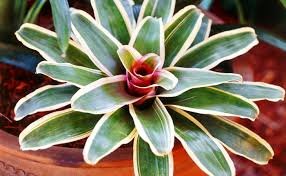
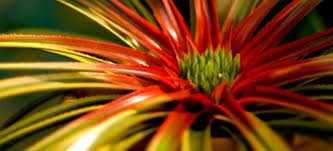
Bromelia, the plant which gives its name to the family, is the main other bromeliad with consumable natural product. Its berries taste somewhat like pineapple, yet are less delicious, and there are not a lot of on each plant.
Fascicularia is the main bromeliad that can be developed in chilly regions. It isn't slaughtered by ice in the event that it is kept dry in the winter.
Pitcairnia is the main wild bromeliad outside the Americas. One animal categories, Pitcairnia feliciana, was discoved living in West Africa. It is presumably dropped from seeds conveyed by moving winged animals.
Puya is the biggest bromeliad. It can grow up to nine meters tall. It lives in the Andes mountains, and is now and again eaten by bears for its nectar. In Chile the youthful leaves of some puyas are eaten in plates of mixed greens.

How to Remove & Pot Up Bromeliad Pups
Bromeliads are easy to propagate because they produce pups (babies) before they die.
he bromeliad pups are very easy to remove. You need to let them grow to a fairly good size, at least 6″ tall, so that the roots have started to form. The bigger the pups, the more root there will be. In the video, I grab them firmly at the base and pull it away from the mother while keeping a good grip on her too. You can also use a clean, sharp knife to cut the pup away.
How To Care For A Bromeliad Plant
Bromeliad plant mind is simple and requires no uncommon instruments or manures. Sustain the plants with a half quality compost each month in the developing season. Water needs are effortlessly accomplished by filling the glass at the base of the takes off. The water that gathers in the pot ought to be purged out week by week to evacuate garbage and the dead creepy crawlies the stale water tends to draw into the container. Set the pot in a saucer of rock filled in part with water to expand mugginess and help give a damp climate. Ensure the roots are not submerged in the water or this may welcome decay. Some bromeliads develop well as "air plants," which are stuck or settled onto logs, greenery or other non-soil natural things. You may have seen Tillandsia plants wired onto coconut shells with no dirt. These plants gather all the sustenance and dampness they require with their leaves yet require a little assistance from you in the indoor setting.
Say blessed
Magoo-2 found a series of multi accounts of a same owner is following your articles to cheat your generous rewards.
Magoo-2 found these accounts are suspicious & can be multi accounts of a single owner. Conclusion is based on last 30 days transactions:
@abdt @wolf-kinght @sardar-sani @tuseef-akram
magoo-2
Check our latest multi comment spam update report
They are among the basal families within the Poales and are the only family within the order that has septal nectaries and inferior ovaries. These inferior ovaries characterize the Bromelioideae, a subfamily of the Bromeliaceae.
Source
Source
The unusual appearance of the bromeliad would seem to indicate that the plant is high maintenance and requires special gardening skills. The plant is prized for its thick foliage that grows in a natural rosette. Near the end of its life, a bromeliad plant may produce an inflorescence or flower whose form and color vary widely among each variety. The wide leaves are sword shaped or scoop-like and grow around a central “cup.” This cup catches water in the plant’s habitat.
How To Grow Bromelaid
These plants are widely available at nurseries and garden centers. The plants need medium to bright light as indoor specimens. New gardeners learning how to grow bromeliads will find that the plant doesn’t need deep pots or thick potting soils. They do even better in shallow pots and may grow in low soil mediums such as orchid mix, a blend of bark, sphagnum moss and other organic amendments.
Source
Source
How To Take Care Of Bromelaid
Feed the plants with a half strength fertilizer every month in the growing season.Water needs are easily achieved by filling the cup at the base of the leaves. The water that collects in the pot should be emptied out weekly to remove debris and the dead insects the stagnant water tends to lure into the cup. Set the pot in a saucer of gravel filled partially with water to increase humidity and help provide a moist atmosphere. Make sure the roots are not submerged in the water or this might invite rot.
Source
Bromeliads are the beautiful plants which adapted to various climates. The plants found worldwide but mainly it's the plant of Australia, South America, Europe and India.
source
People have been using the plants for thousands of years. It's use for food, protection, fiber and ceremony. Such an useful plants.
source
source
Sir @ctrl-alt-nwo you are such a great nature lover man as always share beautiful flowers and plants.
Many interesting Bromelia have grown. Its colorful leaves and stylized leaves are amazing to make the plants as a leafy plant. Some Bromelia carry flowers with attractive shapes and flowers. some are beautiful leaves, shaded with beautiful flowers. especially for pineapple, its fruit can be burned.
Most Bromels grow in pink roses and usually have no trunk. The size of the plant varies, from very small, to Tillandsia to the largest, Puya raimondii. This last plant can reach 10 meters. Naturally, Bromelia grows in different environments, mostly planted in trees as epiphytic plants. There are also growing in soil and rock.
Thank you @ctrl-alt-nwo for sharing good article in steemit...
Bromeliads are members of the pineapple family, Bromeliaceae, and come from tropical parts of the Americas. Many bromeliads are colourful plants and the colour comes either from the flowers or from floral leaves or bracts. They're long flowering, and many types will produce really vibrant displays indoors or out. There are many varieties available in Australia but let's look at three.
Some bromeliads finish flowering, completely die and need to be propagated from seed. But not these. When the rosette dies there should be pups - two young plants ready for new life - at the bottom. Simply remove the soil to reveal where they grow from the base of the plant, and that's where to make the cut to create a new plant.
The potting mix is important. Use an open mix, such as an orchid potting mix, ready made. It's free draining, so it holds some moisture, but not for too long. They like it moist, but need air around the roots. Don't pack down, then insert the cutting. Remember that these plants have wells which need to be filled with water. The plant needs to be kept moist, in a shady spot and the new plant should be flowering within a year.
How to Care for a Bromeliad Plant ;
Bromeliad plant care is easy and requires no special tools or fertilizers. Feed the plants with a half strength fertilizer every month in the growing season. Water needs are easily achieved by filling the cup at the base of the leaves. The water that collects in the pot should be emptied out weekly to remove debris and the dead insects the stagnant water tends to lure into the cup. Set the pot in a saucer of gravel filled partially with water to increase humidity and help provide a moist atmosphere. Make sure the roots are not submerged in the water or this might invite rot. Some bromeliads grow well as “air plants,” which are glued or nested onto logs, moss or other non-soil organic items. You may have seen Tillandsia plants wired onto coconut shells with no soil. These plants collect all the food and moisture they need with their leaves but need a little help from you in the indoor setting.
sourceall
Bromeliads are native to South and Central America, where they are found in environments ranging from hot dry deserts to warm dark rainforests to cool exposed mountainsides. Depending upon the species, they grow on trees (epiphytic), on rocks (saxicolous) and in the ground (terrestrial) in their native habitat but adapt exceptionally well to pot culture.
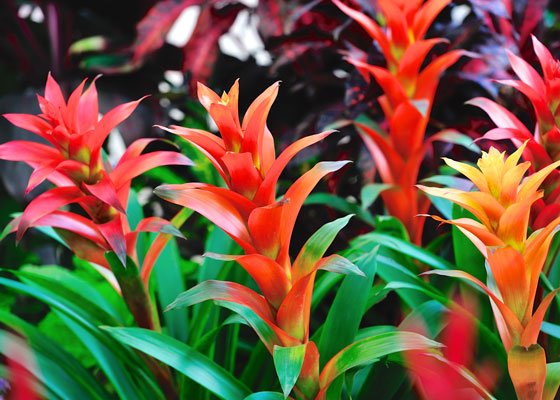
LIFECYCLE

Bromeliads take two to three years to grow to maturity, they flower once, and then gradually die. But during this decline the parent plant produces several offshoots (called pups) which in turn become mature plants. Bromeliads can be left as a clump or the pups can be separated when they are about half the size of the parent plant.
LIGHT
Put your bromeliad in a brightly lit area but protect them from the harshest direct sunlight. 50% shade will suit most bromeliads. ''Ferneries '' are often too dark to maintain good compact growth and colourful leaves.
WATER
Give them a good drenching regularly in warm months. Keep them a bit dryer in winter.
FERTILIZER
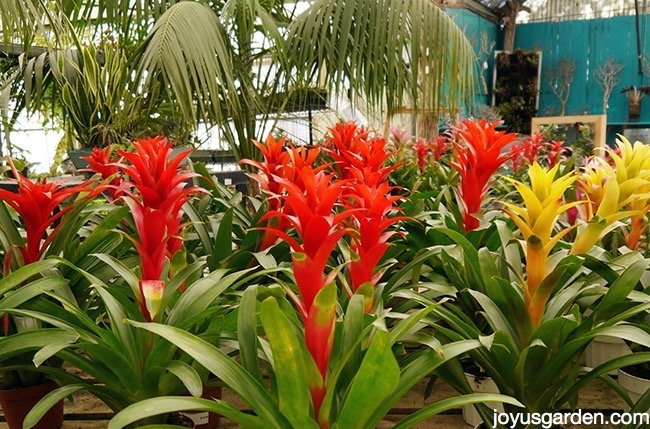
Use half to quarter strength doses of soluble fertilizer occasionally in spring and summer. Bromeliads absorb water and nutrients through their leaves so spray the whole plant with the weak solution . Or, you can add small amounts of slow release fertilizer to the potting mix.
AIR
Put your bromeliad in a position that has good air circulation. Good air circulation and fresh air will promote healthy growth. Bromeliads are not really 'indoor' plants even though some of the shade-loving ones will tolerate life indoors.
TEMPERATURE
Bromeliads like temperatures in the 20's, tolerate temperatures in the 'teens and will survive single figure temperatures.
source
Bromeliad plants provide an exotic touch to the home and bring a sense of the tropics and sun-kissed climates. Growing a bromeliad as a houseplant is easy and brings interesting texture and color to the interior garden. Learn how to care for a bromeliad plant and you will have a long lasting unique houseplant that is low maintenance.
The unusual appearance of the bromeliad would seem to indicate that the plant is high maintenance and requires special gardening skills. The plant is prized for its thick foliage that grows in a natural rosette. Near the end of its life, a bromeliad plant may produce an inflorescence or flower whose form and color vary widely among each variety.
The wide leaves are sword shaped or scoop-like and grow around a central “cup.” This cup catches water in the plant’s habitat. Bromeliad plants are often epiphytic and cling to trees or other structures. They are not parasitic but simply use the structures as perches from which to gather sun and moisture.
These plants are widely available at nurseries and garden centers. The plants need medium to bright light as indoor specimens.
Source
magoo-2 found a series of multi accounts of a same owner is following your articles to cheat your generous rewards.
magoo-2 found these accounts are suspicious & can be multi accounts of a single owner. Conclusion is based on last 30 days transactions:
@readerhubs @imbooster
magoo-2
Check our latest multi comment spam update report
Bromeliads have shapes that you want to touch to check whether they really are real. And they are: design by nature and easy to live with as well. In exchange for a bit of light and a sip of water, they treat you to spectacular colours and a tropical look.
What we often think of as flowers are actually coloured bracts. The actual Bromeliad flowers themselves are very small. There are more than 2800 species, the most beautiful and easiest of which have been adopted as houseplants. The best-known are Guzmania (trumpet), Aechmea (silver-grey rosette), Vriesea (feather shapes), Neoregalia (red calyx) and Tillandsia (antennae and paddles). The club also includes the (ornamental) pineapple plant (Ananas), Nidularium, Billbergia (hanging) and Cryptyantus. All Bromeliads have a positive effect on air quality.
ncas, Aztecs and Mayans used almost every part of the plant for food, shelter, fibres and ceremonies. As a result, the Bromeliad is viewed as a ‘gift from the gods’ in its native countries. As a houseplant, Bromeliad represents ‘protection’: a reference to the full, green foliage that surrounds the beautiful coloured part.
SOURCE
magoo-2 found a series of multi accounts of a same owner is following your articles to cheat your generous rewards.
magoo-2 found these accounts are suspicious & can be multi accounts of a single owner. Conclusion is based on last 30 days transactions:
@saadsaeed @azharhussain
magoo-2
Check our latest multi comment spam update report
scanbot found a series of multi accounts of a same owner is following your articles to cheat your generous rewards.
scanbot found these accounts are suspicious & can be multi accounts of a single owner. Conclusion is based on last 30 days transactions:
@saadsaeed @azharhussain
scanbot
Check our latest multi comment spam update report